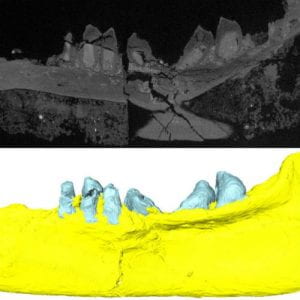Matthew Skinner, who completed the MSc in Palaeobiology at Bristol in 2019, has just published his research in Proceedings of the Geologists’ Association. He studied a collection of fossils rom Ruthin Quarry in South Wales, which in the Late Triassic was a small island set in a tropical sea. Matthew discovered that most of the Ruthin beasts showed greatest similarity to relatives from North America.
He also fou nd that many of the reptiles were more primitive than expected, a common feature of island species, and there was some evidence for the species-area effect (many animals on large islands; fewer on small islands). Matthew also named a new species, Smilodonterpeton ruthinensis (‘chisel-toothed reptile from Ruthin’), a procolophonid with strange, chisel-like teeth, and he used Ct scanning to determine the true nature of a mystery reptile that had been named from Ruthin in the 1950s, the plant-eating Tricuspisaurus thomasi (see scan and 3D digital model).
nd that many of the reptiles were more primitive than expected, a common feature of island species, and there was some evidence for the species-area effect (many animals on large islands; fewer on small islands). Matthew also named a new species, Smilodonterpeton ruthinensis (‘chisel-toothed reptile from Ruthin’), a procolophonid with strange, chisel-like teeth, and he used Ct scanning to determine the true nature of a mystery reptile that had been named from Ruthin in the 1950s, the plant-eating Tricuspisaurus thomasi (see scan and 3D digital model).
Read Matthew’s paper here.

